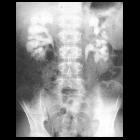congenital megacalyectasis
 ähnliche Suchen
ähnliche Suchen siehe auch
siehe auchCongenital megacalyces is an incidental finding which mimics hydronephrosis. It is a result of underdevelopment of the renal medullary pyramids with resultant enlargement of the calyces. It is more frequently seen in males.
The enlarged calyces predispose to stasis, infection and calculus formation. There is an association with congenital megaureter.
Terminology
This condition is sometimes differentiated from megapolycalycosis which means "enlarged and numerous calyces." Some have differentiated between "megacalycosis" (large calyces, but normal number of calyces) and "polycalycosis" (greater than normal number of calyces, but normal size). Congenital megacalyces in this scheme would be "megacalycosis." It is unclear how often polycalycosis occurs; this condition is, at most, extremely rare.
Epidemiology
Associations
Radiographic features
Intravenous/CT/MR urography and retrograde pyelography
Due to the lack of normal medullary pyramids, not only are the calyces enlarged but they lack the normal imprint from the papillae, and the calyces have a flat appearance . The renal pelvis is of normal size helping to distinguish megacalyces from hydronephrosis.
In addition to enlargement of the calyces, there is often also polycalycosis (increased number of calyces); they are crowded and multifaceted with a mosaic-like appearance.
Treatment and prognosis
Congenital megacalyces usually do not require any treatment unless complicated by calculi or infection which then may require specific management.
Siehe auch:
und weiter:
 Assoziationen und Differentialdiagnosen zu Megakalikose:
Assoziationen und Differentialdiagnosen zu Megakalikose:





